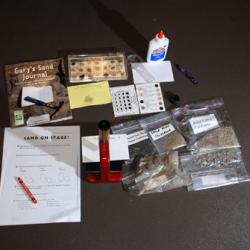Source Institutions
Source Institutions
Add to list Go to activity
Activity link broken? See if it's at the internet archive

In this activity, learners observe mixtures of sand samples glued to note cards, and consider how sand can differ in size, shape, and color, and where it comes from. The goal is to help learners formulate questions such as what kind of material sand is composed of, and how do the local geology, weather and ocean affect the qualities of sand on a particular beach. The lesson plan includes a flow chart that shows how an educator might guide an interaction with a learner (pages 11-12 of PDF). It is written for use in a science center or aquarium, but it can be done anywhere.
- 30 to 45 minutes
- 10 to 30 minutes
- 1 cent - $1 per group of students
- Ages 4 - adult
- Activity, Lesson/Lesson Plan
- English
Quick Guide
Materials List (per group of students)
- 2 sets of 6 small resealable bags containing different sand samples labeled with their location
- 5 bottles of white glue
- a few packs of index cards (1/2 white, 1/2 colored)
- 5-10 hand lenses
- “scope on a rope” with monitor and/or individual microscopes
- 5 rock and mineral kits
- collections of small samples of marine animal “hard parts” -coral, shells, sand dollar test, exoskeletons of crabs, bones
- at least 4 very different types of sand to make at least 2 sets of sand samples (see Procedure and Set up section)
- crayons, colored markers and pencils
- sand shape sign, and sand size gradient sign
- pictures of the locations where your sand samples are from
- pictures of sand or sand poster
- copies of the Mystery Sand worksheet (from PDF)
- Optional, but helpful: Globe or world map, blank paper
Subjects
-
Earth and Space Science
-
Earth Structure
- Rocks and Minerals
- Oceans and Water
-
Earth Structure
Informal Categories
- Nature and Environment
Audience
To use this activity, learners need to:
- see
- see color
- touch
Learning styles supported:
- Involves hands-on or lab activities
Other
Includes alignment to state and/or national standards:
This resource is part of:
Access Rights:
- Free access
By:
Rights:
- All rights reserved, Regents of the University of California, Berkeley, 2009
Funding Source:
- National Science Foundation, NSF OCE-0731338
